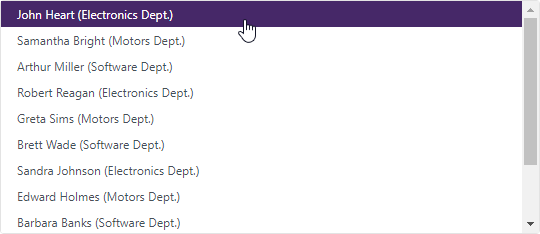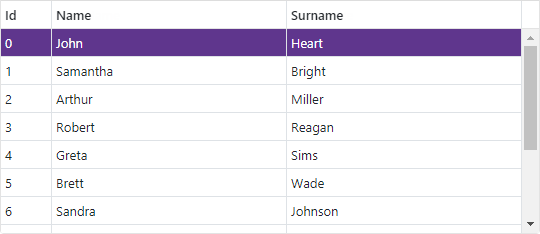DxListBox<TData, TValue> Class
A List Box component.
Namespace: DevExpress.Blazor
Assembly: DevExpress.Blazor.v20.2.dll
NuGet Package: DevExpress.Blazor
Declaration
public class DxListBox<TData, TValue> :
DxResizableEditorBase<TData, ListBoxJSInteropProxy>,
IDataSourceSettings<TData>,
IHandleDataLayoutChanged,
IServiceProviderAccessor,
IRequireSelfCascading,
IListBoxJSInteropProxyServer,
IJSCallbackType Parameters
| Name | Description |
|---|---|
| TData | The data item type. |
| TValue | The value type. |
Remarks
DevExpress List Box for Blazor (<DxListBox>) allows you to display a list of selectable items from a data source.

Add a List Box to a Project
Follow the steps below to add the List Box component to an application:
- Use a DevExpress Project Template to create a new Blazor Server or Blazor WebAssembly application. If you use a Microsoft project template or already have a Blazor project, configure your project to incorporate DevExpress Blazor components.
- Add the
<DxListBox>…</DxListBox>markup to a Razor page. - Bind the component to data.
- Configure the component (see the sections below).
Bind to Data
Use the Data property to bind the List Box to a strongly typed collection. Initialize this collection in the OnInitialized lifecycle method or before this method is invoked. Use the DataAsync property instead of the Data property if a strongly typed collection is loaded asynchronously (for instance, from an HTTP request).
Use the Values property to specify to the component’s selected value/item collection. You can use the @bind attribute to bind the Values property to a data field. Refer to Two-Way Data Binding.
<DxListBox Data="@Cities" @bind-Values="@Values"></DxListBox>
@code {
IEnumerable<string> Cities = new List<string>() {
"London",
"Berlin",
"Paris",
};
IEnumerable<string> Values { get; set; }
}
The List Box can detect IQueryable<T> collections and use benefits of the corresponding LINQ query providers (such as Entity Framework).
If a data collection stores custom objects (IEnumerable<CustomType>), override the object’s Equals method and set the TextFieldName property to specify the field name with item values. Otherwise, the List Box is populated with CustomType.ToString() values.
@using BlazorApp.Data
<DxListBox Data="@Staff.DataSource"
@bind-Values="@Values"
TextFieldName="@nameof(Person.Text)">
</DxListBox>
@code {
IEnumerable<Person> Values { get; set; } = Staff.DataSource.Take(1);
}

If your data is stored on a remote service and is loaded through a Web API, assign the data type to the component’s T parameter and use the CustomData property to implement data load logic.
Item Selection
A user should click a List Box item to select it. To access the selected item in code, use the Values collection. To handle selection changes, use the ValuesChanged event.
To enable multi selection in List Box, set the SelectionMode property to ListBoxSelectionMode.Multiple. In this mode, a user should click the initial item, hold the Shift key, and select the final item to specify the range of items. To add/remove individual items to/from the selection, a user should click an item with the Ctrl key pressed.
To disable selection in List Box, set the SelectionMode property to ListBoxSelectionMode.None.
Note
You can also enable the ShowCheckboxes property to allow users to select items via checkboxes.
The code below demonstrates how to enable multiple selection via checkboxes in List Box.
<DxListBox Data="@Staff.DataSource"
TextFieldName="@nameof(Person.Text)"
SelectionMode="ListBoxSelectionMode.Multiple"
ShowCheckboxes="true"
@bind-Values="@Values">
</DxListBox>
@code {
IEnumerable<Person> Values {
get => Values;
set { Values = value; InvokeAsync(StateHasChanged); }
}
}

Multiple Columns
The List Box can display data across multiple columns. To create columns, use DxListEditorColumn objects that include the following options for column customization:
- FieldName - Specifies the data source field that populates column items.
- Caption - Specifies the column header.
- Visible - Specifies the column visibility.
- VisibleIndex - Specifies the column display order.
- Width - Specifies the column width.
<DxListBox Data="@Staff.DataSource"
@bind-Values="@Values"
style="height: 232px;">
<DxListEditorColumn FieldName="Id" Width="50px" />
<DxListEditorColumn FieldName="FirstName" Caption="Name"/>
<DxListEditorColumn FieldName="LastName" Caption="Surname"/>
</DxListBox>
@code {
IEnumerable<Person> Values { get; set; } = Staff.DataSource.Take(1);
}

Virtual Scrolling
Set the ListRenderMode property to ListRenderMode.Virtual to enable virtual scrolling. In this mode, the List Box loads data on demand when a user scrolls list items.
<DxListBox Data="@Staff.DataSource"
TData="Country"
TValue="Country"
ListRenderMode="ListRenderMode.Virtual">
</DxListBox>
Input Validation
You can add a standalone List Box or the Form Layout component to the Blazor’s standard EditForm. This form validates user input based on data annotation attributes defined in a model and indicates errors.
<EditForm Model="@model" Context="EditFormContext">
<DataAnnotationsValidator />
<DxFormLayout >
<DxFormLayoutItem Caption="Values:" ColSpanMd="6" >
<Template>
<DxListBox NullText="Select values ..."
ClearButtonDisplayMode="DataEditorClearButtonDisplayMode.Auto"
Data="@(new List<string>() { "Defense", "Exploration", "Diplomacy" })"
@bind-Values="@model.Values" />
</Template>
</DxFormLayoutItem >
@*...*@
</DxFormLayout>
</EditForm>
@code {
private Model model=new Model();
}
For more information, refer to the following help topic: Validate Input.
Read-Only State
<DxListBox> supports a read-only state. Set the ReadOnly property to true to activate this option.
<DxListBox Data="@Staff.DataSource" Values="@Values" ReadOnly="true" />
@code {
IEnumerable<Person> Values => Staff.DataSource.Take(1);
}